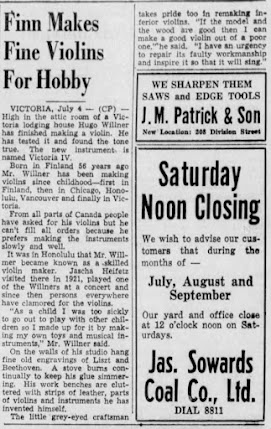About
Hugo Willner (or Wilner) was a Finnish luthier born June 24, 1887 in Gawlakarleby, Finland to parents Andrew and Johanna. His family left the old country and by 1892 had relocated to Seattle, Washington where Andrew worked as a carpenter. His upbringing is relatively opaque but by 1917, he had moved to Hawaii and was working for John A. Templeton in the pineapple business.
Willner became a naturalized US Citizen in 1919 and by 1922 was working as a violin maker and repairman for the Hawaii Sales Co Ltd at 1009 Nuuanu Avenue [5]. Evidently that didn't pay the bills because in 1923 he was working as a salesman for Hawaiian News & Thrum's [7]. But fortune turned around and in 1924 he was the owner of Willner's Music Shop in Honolulu [4]
In 1928, he left Hawaii with $500 on his person destined for a new life. He stopped in Seattle, first, to visit his family and then departed for British Columbia where a job at the Vancouver Music Company awaited him [3][8].
A 1932 auction of donated goods held by local celebrity, Big Brother Bill, featured a Hawaiian guitar donated by Hugo. It was bought by a Mr Eric Brown for 18.25 [2]. In 1944, he moved to room 3 at 1116 Broad Street [1]
 |
| 1944 Article on Hugo Willner Image Credit: Newspapers.com |
Hugo died in 1956 at the age of 68. He was living in Richmond, BC and his only surviving relative was an unnamed sister living in the US. His grave marker in the Forest Lawn Memorial Park includes his rank in the US Quarter Master Corps
 |
| Image Credit: Find a Grave |
 |
| 1943 Article on Willner entitled "The Blue Flower" by Iris Smallwood The poor resolution is from the source material Image Credit: Newspapers.com |
Instruments
The instruments built by Hugo Willner are far and few between and his guitars seem to borrow heavily from the designs of larger firms. To date, I have not found any examples of his violin work and only a handful of guitars have appeared on the internet.
His instruments are identifiable via his name stamp which is pressed into the braces and neck block. His serial numbers are penciled on the neck block and as of writing #1306 is the highest serial number. It is unclear whether he was counting his repaired instruments or whether he actually started at 0 and counted up.
Flat Top
His flat top guitars borrow from the Martin styling except are provided with a larger pickguard not unlike a Euphonon. Based on the references I've seen on the internet, they can be ladder or X braced.
 |
| Hugo Willner #1273 Flat Top Guitar Image Credit: Reverb - Robert's Gear Depot |
This example is curious as it uses an archtop bridge in conjunction with pins directly in the soundboard.
 |
| Hugo Willner #? Flat Top Guitar Image Credit: Canadian Listed.com |
Archtop
Thus far only one archtop guitar from Willner has surfaced. The neck looks like Willner's work but the body, surprisingly, looks exactly like a early 1950s Kay archtop. The sunburst is smaller and crude but the F holes and top and back carves are identical to the pressed archtops of Chicago.Carving an archtop is a monumental undertaking even for an experienced violin builder and Hugo would've been quite old around the time this instrument was completed.
I don't believe it is unreasonable to suggest that Hugo found it easier to reneck a Kay archtop.
 |
| Hugo Willner #1306 Archtop Guitar Image Credit: Reverb - Chris Music Man |
Patents
US2473980/CA458184
Hugo filed one patent in his lifetime and it was for a novel bracing idea for an acoustic guitar. His patent was filed on February 16th, 1948 and intended to strengthen the top of the acoustic guitar and prevent it from warping due to string tension.
One unique trait are the addition of two tension wires inside the body which pass from the transverse fingerboard brace, through any other parallel braces, and finally end in the tailblock where two nuts are provided to tension them. The patent mentions that the strings can be tuned to match the guitar or to another tension as desired. He also suggests that tension on the wires can be used to stiffen or loosen the top to change the sound of the instrument.
Wellner references three patents:
1892 - US476907 - A single tension wire inside of a violin
1911 - US1128217 - Joseph Bohmann's patent for tension rods inside the body of a mandolin
1916 - US1214075 - Two tension wires inside a violin to counteract the string tension
Sources
[1] https://www.newspapers.com/image/505796444/?terms=%22hugo%20willner%22&match=1
[2] https://www.newspapers.com/image/490563658/?terms=hugo%20willner&match=1
[3] https://www.newspapers.com/image/498982808/?terms=%22hugo%20willner%22&match=1
[4] https://www.ancestry.com/imageviewer/collections/2469/images/16036761?treeid=182251037&personid=312363541834&usePUB=true&_phsrc=zMK445&_phstart=successSource&pId=1039959672
[5] https://www.ancestry.com/imageviewer/collections/2469/images/16174476?treeid=182251037&personid=312363541834&usePUB=true&_phsrc=zMK445&_phstart=successSource&pId=1049338989
[6] https://www.ancestry.com/imageviewer/collections/2469/images/16222566?treeid=182251037&personid=312363541834&usePUB=true&_phsrc=zMK445&_phstart=successSource&pId=1052670662
[7] https://www.ancestry.com/imageviewer/collections/2469/images/16041145?pId=1040208385
[8] https://www.ancestry.com/imageviewer/collections/1344/images/30928_2000913131-00429?pId=2680178












No comments: